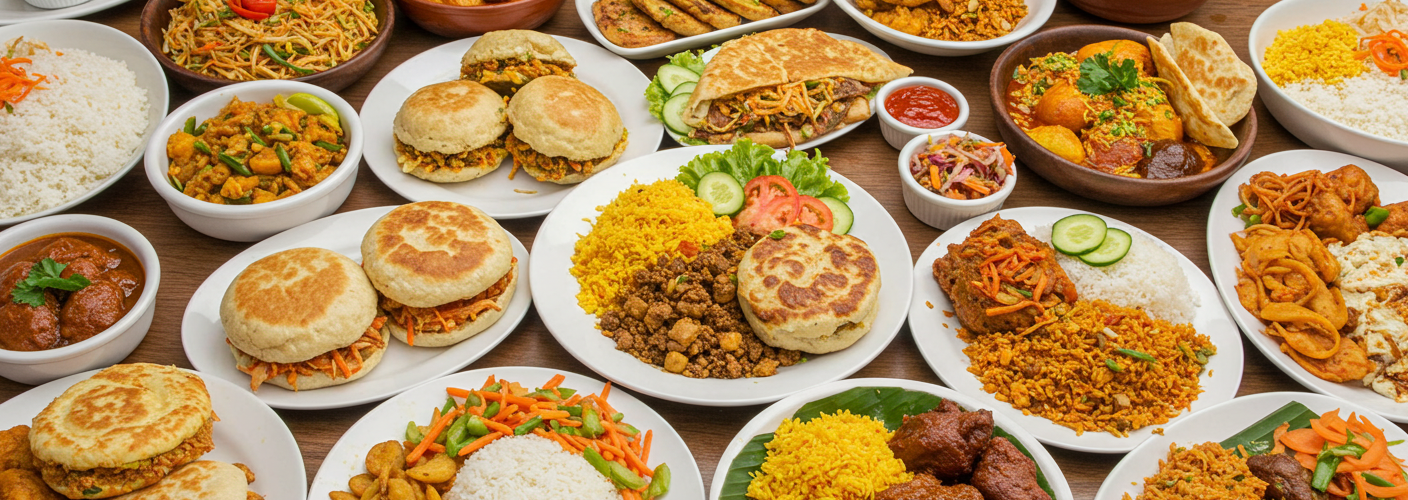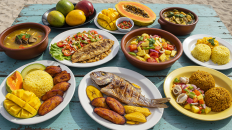Trinidad and Tobago, a twin-island nation in the Caribbean, is renowned not just for its vibrant culture and scenic landscapes but also for its diverse and flavorful cuisine. The culinary landscape here reflects the rich tapestry of influences that have shaped the islands over centuries, incorporating elements from Indigenous, African, Indian, Chinese, and European traditions. This blend creates a distinctive food culture that is as varied as the people who inhabit the islands.
One of the most iconic dishes in Trinidad and Tobago is roti, which originated with the Indian population. Roti is a flatbread that is often served with various types of curried dishes, including chicken, goat, or lentils. Dahlpuri roti, which is stuffed with ground split peas, has a unique flavor that distinguishes it from the more common paratha roti, known for its flaky texture. Roti is so popular that you can find it at many street vendors, restaurants, and even at family gatherings, making it a staple of everyday meals.
Another quintessential dish is doubles, a popular street food that showcases the Indian influence on Trini cuisine. Doubles consist of two soft bhaji (fried flatbreads) filled with spicy curried chickpeas, topped with a tangy tamarind sauce and various chutneys. This dish epitomizes the essence of Trinidadian food – bold flavors, a touch of heat, and a satisfying, hearty bite. Vendors can be found throughout the islands, especially during lunchtime, serving up these delicious treats to hungry locals and tourists alike.
Seafood also plays a significant role in the culinary scene. The proximity to the ocean means that fresh fish is a commonly enjoyed protein. Dishes such as callaloo, made with young dasheen leaves, coconut milk, and often with crab or fish, are hearty and full of flavor. The use of local spices in seafood dishes reflects the islands’ diverse influences, ensuring every bite is a delightful experience.
Barbecues in Trinidad and Tobago are truly a festive affair. The famous corn soup, made with corn, vegetables, and spices, is often served at these gatherings alongside grilled meats. Pork, chicken, and fish are marinated in a blend of local spices and cooked to perfection, infusing each bite with an explosion of flavor. During Carnival season, the aroma of barbecued meats fills the air, drawing people together in communal celebration.
As we explore Trinidad and Tobago’s culinary offerings further, we cannot overlook the importance of souse in the culinary culture. This dish, typically made from pickled chicken feet, pig’s feet, or even beef, is prepared with vinegar, lime, and a variety of seasonings, resulting in a tangy, flavorful treat. Souse is often served cold, making it a refreshing dish, particularly in the tropical heat. This is particularly popular on weekends, with families often gathering to enjoy it together.
The islands’ street food culture provides a fantastic opportunity to experience the local flavors without breaking the bank. Vendors sell an array of delicacies including pholourie, spiced dough balls served with a mango chutney, and fritters, which can be made with a variety of ingredients, from salt fish to vegetables. These snacks are perfect for those looking to indulge in authentic Trinidadian tastes while wandering the vibrant streets.
Desserts in Trinidad and Tobago are an exciting chapter in the country’s culinary story. A popular choice is tamarind ball, made from the pulp of tamarind, sugar, and spices, rolled into bite-sized balls. Similarly, coconut drops, which are sweet confections made from grated coconut and brown sugar, are another beloved treat, celebrated for their chewy texture and rich flavor.
It is intriguing to note how traditional dishes have evolved, influenced by globalization and modern cooking techniques. Many gourmet restaurants now put their own twist on classic recipes, creating fusion dishes that blend local ingredients with international cuisine. This has reinvigorated the food scene, providing both locals and tourists with fresh interpretations of familiar flavors.
In addition to the variety of foods available, Trinidad and Tobago is also known for its vibrant drinks. Mauby, derived from the bark of the mauby tree and flavored with spices like anise and cinnamon, is a popular, refreshing beverage often enjoyed chilled. Another favorite is sorrel drink, made from the calyces of the sorrel plant, ginger, and sugar, typically served during the holiday season.
When discussing food in Trinidad and Tobago, it is impossible to ignore the role of communal eating in local culture. Meals are often enjoyed with family and friends, reinforcing social bonds and creating a sense of belonging. Food festivals, such as the annual Trinidad and Tobago Food Festival, celebrate the country’s culinary arts and highlight local chefs and cuisine. The joyful atmosphere at these events is a testament to the shared love for food and community, making it a vibrant and integral part of national identity.
In conclusion, the food culture of Trinidad and Tobago is a captivating blend of traditions and influences, creating a culinary landscape that is rich, diverse, and incredibly flavorful. From the iconic roti and doubles to delectable seafood and sweets, every dish tells a story of the islands’ history and its people. As both locals and visitors indulge in this vibrant gastronomic journey, they are reminded of the warmth and sense of community that the food evokes, making Trinidad and Tobago a true haven for any food lover.




Add comment